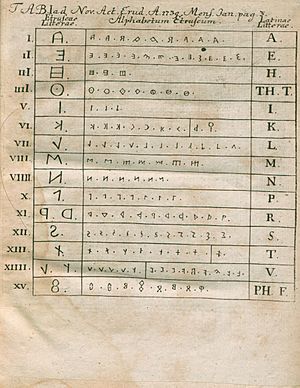Antonio Francesco Gori facts for kids
Quick facts for kids
Antonio Francesco Gori
|
|
|---|---|

Antonio Francesco Gori by Johann Jacob Haid
|
|
| Born | 9 November 1691 Florence, Grand Duchy of Tuscany |
| Died | 20 January 1757 Florence, Grand Duchy of Tuscany |
| Resting place | Basilica of St. Mark |
| Occupation | Priest, etruscologist, university teacher, archaeologist |
| Employer | |
| Position held | provost (1746–1757) |
Antonio Francesco Gori (born 9 December 1691, died 20 January 1757) was an Italian scholar who loved studying ancient objects. He was a priest and a professor in Florence. Gori published many books about ancient Roman sculpture and other old artifacts. His work helped shape how people studied history and art in the 1700s.
In 1735, Gori helped start a group of scholars in Florence called the Società Colombaria. This group wanted to study many different areas of human knowledge, like a big encyclopedia.
Gori's Early Discoveries
As a young man, Gori studied with Anton Maria Salvini. He was also inspired by Filippo Buonarroti's studies of the Etruscan people. The Etruscans were an ancient civilization in Italy before the Romans.
In 1726, Gori made an important discovery near Rome on the Via Appia. He found a columbarium, which was a burial place for many people. This one belonged to the household of Livia, who was the wife of Emperor Augustus.
The next year, Gori published a book about his discovery. It was called Monumentum sive columbarium libertorum et servorum Liviae Augustae. The book included 21 detailed drawings. Each drawing was dedicated to an important art supporter or scholar. One was for Joseph Smith, an English merchant who collected art in Venice. Another was for Sir Thomas Dereham, an Englishman who lived in Florence.
Also in 1727, Gori published a collection of classical writings called Inscriptiones graecae et latinae. This book contained ancient Greek and Latin inscriptions.
The Museum Florentinum Project
Gori became famous across Europe for his huge project, the Museum Florentinum. He started working on it in the early 1730s. This project was a detailed visual record of the Medici family's collections in Florence. It included all kinds of ancient artifacts.
The Museum Florentinum eventually grew to twelve large books. They were published between 1731 and 1766. Gori worked with artists like Giovanni Domenico Campiglia and Giovanni Domenico Ferretti. These artists drew copies of famous artworks. Gori then oversaw the engraving and publishing of these drawings.
- The first book, published in 1731–32, showed ancient cameos and portraits. It had 200 plates.
- The second book, from 1734, focused on Roman statues and monuments. It had 100 plates and was dedicated to Gian Gastone de' Medici. He was the last of the Medici Grand Dukes.
- The third book, published in 1740 and 1742, featured ancient gold, silver, and bronze coins. It had 121 plates.
- A fourth book simply showed fifty portraits of famous artists, architects, sculptors, and engravers.
The Museum Florentinum was important because it described many sculptures and ancient items in the Medici collections for the first time.
Other Important Books
Gori also published ancient writings found in Etruria. These were part of his Museum Etruscum series, which had three books published between 1736 and 1743. These books were some of the very first studies of the Etruscan civilization. Gori had some disagreements with another Etruscan scholar, Francesco Scipione Maffei, over their studies.
He also edited a collection of ancient writings by Giovanni Battista Doni in 1731. Gori published a book about ancient ivory diptychs. These were two-paneled artworks from the Late Antique and Byzantine periods.
In 1750, Gori worked with Ridolfino Venuti and Francesco Valesi on Museum cortonense. This book described ancient items in Cortona, both in the local academy and in noble families' collections.
Gori also created a catalog of carved gems owned by Antonio Maria Zanetti, an art dealer. Later, he made a catalog for Consul Joseph Smith's collection of carved gems and cameos. This book, Dactyliotheca Smithiana, was published in 1767. It described the gems and included a history of gem engraving.
One of Gori's other important works was an early description of the first discoveries at Herculaneum in 1748. Herculaneum was an ancient Roman town buried by a volcanic eruption. Gori also studied Greek vases found in Etruria.
In 1751, Gori published the Satire (Satires) by Jacopo Soldani.
Gori is also remembered for his connection to Galileo Galilei. It is said that Gori took one of Galileo's fingers from his tomb in Santa Croce. This happened when Galileo's remains were moved in 1737. The finger was kept in a bottle in the Laurentian Library and shown to visitors.
Antonio Francesco Gori is buried in the church of San Marco in Florence.


